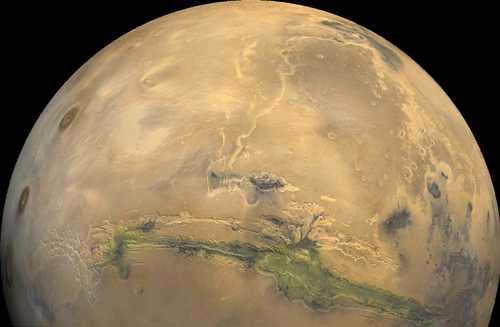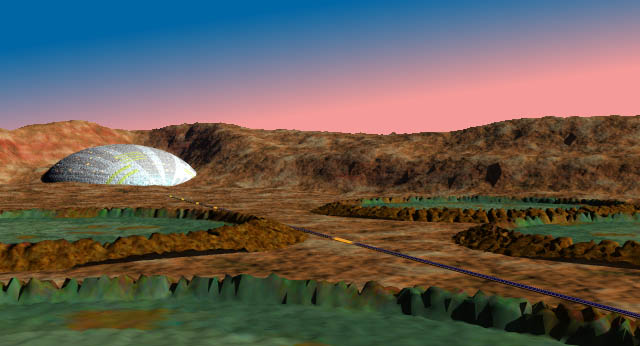 Republic of Mars
Republic of Mars
 History: History: Much of the History of Mars is given in the general history. Mars experienced the greatest population boom from the Earth Refugess of 2145. Fully half of the population of Mars is of EarthGov descent. Unfortunately, these people arrived with little or no material wealth, training or education. These Carpetbaggers, or “Vacc-backs” are second-class citizens to this very day. While the average Pure Martian lives in one of the great domed Arcologies in Mariner Valley, the average Refugee-descendent lives in the old caves in the canyon walls that housed the original settlers. These caves are vast and roomy, far more space than is needed, but they are plagued by insufficient power, schooling, medicine and other social services. Many attempts were made in the last two decades to alleviate some of this disparity between the classes, but the current government is run by the Conservative Party, which has tempered some of the recent “giveaway programs” with incentive based work programs. The sad fact is that the old Martians live a comfortable middle-to-upper class existence, while the vast majority of food production and construction (“outside work”), is done by the new Martians. It is a situation with a lot of social inertia which is unlikely to change anytime soon.
History: History: Much of the History of Mars is given in the general history. Mars experienced the greatest population boom from the Earth Refugess of 2145. Fully half of the population of Mars is of EarthGov descent. Unfortunately, these people arrived with little or no material wealth, training or education. These Carpetbaggers, or “Vacc-backs” are second-class citizens to this very day. While the average Pure Martian lives in one of the great domed Arcologies in Mariner Valley, the average Refugee-descendent lives in the old caves in the canyon walls that housed the original settlers. These caves are vast and roomy, far more space than is needed, but they are plagued by insufficient power, schooling, medicine and other social services. Many attempts were made in the last two decades to alleviate some of this disparity between the classes, but the current government is run by the Conservative Party, which has tempered some of the recent “giveaway programs” with incentive based work programs. The sad fact is that the old Martians live a comfortable middle-to-upper class existence, while the vast majority of food production and construction (“outside work”), is done by the new Martians. It is a situation with a lot of social inertia which is unlikely to change anytime soon.
 People: Martians (Farmers, Vacc-backs, Caverners)
People: Martians (Farmers, Vacc-backs, Caverners)
The Arcologies are great planned cities with excellently designed living units and efficient mass transit systems. They are usually dome-like in shape with great internal space, filled with industrious, clean and happy people. Parks are common, and Mars is the only place in the Solar Sysem wher one can sit under the shade of a tree. There is some innocuous wildlife (dogs, cats, several species of bird). Mars is constantly trying to buy frozen ova of the more exotic animals which are owned by Luna. Luna is loathe to give these up, for they are priceless to risk transporting and represent one of Luna’s truly unique resources (See Copernicus’ Luna Zoo). The Martian Government would also like to use the animals for genetic engineering, with the possibility of breeding life to live on the Martian surface unaided. The Arcologies are all linked by transit tubes, and one may travel from city to city without putting on any cold weather gear.
The Caverns are a different story. They were hastily enlarged in 2045-2055 to make room for the vast influx of refugees. The caverns are cramped in many places, and lack adequate ventilation in others. Whereas the arcologies enjoy 1 standard atmosphere of pressure at a comfortable 72°F, the average cavern air pressure is about half that. Temeratures vary wildly in the caverns, depending on ventilation and population density. Where many people gather to do business, it can become stiflingly hot, where the intake compressors supply the fresh air, there is little difference from the chilling freeze of outside. There are long rattling railways that take workers to and from the fields or to major population concentrations within the caves themselves, but mostly everybody walks. In many places the machinery that maintains the Caverns is old and in disrepair. The Caverns are often requesting more money for environmental equipment. Mars has a political setup remeiniscent of the American South at the beginning of the Civil Rights Movement.

Areopagus Dome
The Farms themselves are a wonder of engineering, both mechanical and genetic. Incredibly hardy varieties of earth grains and even a few tubers vegetables and fruits grow in vast circular farms. The soil of the farms is laced with engineered bacteria. These bacteria are symbiotically linked to the plants to aid in growth and water collection. The bacteria eat a nutrient released into the water before it is pumped into the soil. Once the water has frozen, the bacteria consume ice crystals. The act of metabolizing the nutrient is only possible with an enzyme secreted by the roots of the plants. The action of metaboism releases enough heat to melt the ice crystal. Remember, this is on a microscopic scale; the crystals have a very small surface area-to-volume ratio. Thus there is a state of dynamic equilibrium, with the bacteria constantly supplying water to the roots of the crops. This is quite difficult to maintain properly, and requires constant testing and supervision. Although much cultivation could be done by machine, the farmrs have grown far faster than the Martian economy’s ability to manufacture the equipment necessary to grow and cultivate. The simple fact is that there is a large cheap labor force that has little training other than farm labor. Besides most of the industry of the last century was expended on the Arcologies and the Caverns. There are many political lobby groups that would like to se the farms automated and the workers re-trained. Others counter with the fact that the current system works, and why mess with it; what would you do with all those…people?
 History: History: Much of the History of Mars is given in the general history. Mars experienced the greatest population boom from the Earth Refugess of 2145. Fully half of the population of Mars is of EarthGov descent. Unfortunately, these people arrived with little or no material wealth, training or education. These Carpetbaggers, or “Vacc-backs” are second-class citizens to this very day. While the average Pure Martian lives in one of the great domed Arcologies in Mariner Valley, the average Refugee-descendent lives in the old caves in the canyon walls that housed the original settlers. These caves are vast and roomy, far more space than is needed, but they are plagued by insufficient power, schooling, medicine and other social services. Many attempts were made in the last two decades to alleviate some of this disparity between the classes, but the current government is run by the Conservative Party, which has tempered some of the recent “giveaway programs” with incentive based work programs. The sad fact is that the old Martians live a comfortable middle-to-upper class existence, while the vast majority of food production and construction (“outside work”), is done by the new Martians. It is a situation with a lot of social inertia which is unlikely to change anytime soon.
History: History: Much of the History of Mars is given in the general history. Mars experienced the greatest population boom from the Earth Refugess of 2145. Fully half of the population of Mars is of EarthGov descent. Unfortunately, these people arrived with little or no material wealth, training or education. These Carpetbaggers, or “Vacc-backs” are second-class citizens to this very day. While the average Pure Martian lives in one of the great domed Arcologies in Mariner Valley, the average Refugee-descendent lives in the old caves in the canyon walls that housed the original settlers. These caves are vast and roomy, far more space than is needed, but they are plagued by insufficient power, schooling, medicine and other social services. Many attempts were made in the last two decades to alleviate some of this disparity between the classes, but the current government is run by the Conservative Party, which has tempered some of the recent “giveaway programs” with incentive based work programs. The sad fact is that the old Martians live a comfortable middle-to-upper class existence, while the vast majority of food production and construction (“outside work”), is done by the new Martians. It is a situation with a lot of social inertia which is unlikely to change anytime soon.
 People: Martians (Farmers, Vacc-backs, Caverners)
People: Martians (Farmers, Vacc-backs, Caverners)